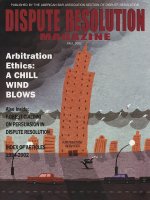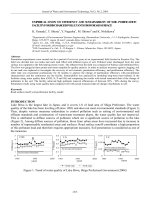SCIENCE OF SOIL
Bạn đang xem bản rút gọn của tài liệu. Xem và tải ngay bản đầy đủ của tài liệu tại đây (1.16 MB, 54 trang )
SCIENCE OF
SOIL
1
Soil
A collection of natural bodies developed in the
unconsolidated mineral and organic material on the
immediate surface of the earth that serves as a natural
medium for the growth of land plants and has
properties due to the effects of climate and living
matter acting upon parent material, as conditioned by
topography, over a period of time.
2
GENESIS OF SOIL
Rocks are chief sources for the parent material
over which soils are developed
Types of rocks Igneous
Sedimentary
Metamorphic
Genesis includes –weathering of rocks &
formation of soil
3
Primary and Secondary
Minerals
Primary Minerals: Minerals that have persisted with
little change in composition since they were
extruded in molten lava(eg. quartz, mica and
feldspars).They are most prominent in sand and silt
fractions.
Secondary Minerals: Minerals such as the silicate
clays and iron oxides, have been formed by the
breakdown and weathering of less resistant
minerals as soil formation progressed.
4
Weathering of rocks
It is physical and chemical disintegration and
decomposition of rocks. Weathering creates
the parent material over which the soil
formation takes place. Later weathering, soil
formation
and
development
proceeds
simultaneously.
5
Physical weathering
Temperature
Water
Wind
Plants & animals
6
Chemical weathering
Solution
Hydration
Hydrolysis
Acidification
Oxidation
Reduction
7
Soil formation
The mineral weathering combines with the
associated physical and chemical phenomena
constitute the process of soil formation.
It includes1. The addition of organic & mineral materials
2. The loss of these materials from the soil
3. Translocation of materials from one point to
Another within the soil column
4. Transformation of minerals & organic substances
within the soil
8
Two Approaches:
Pedological
Edaphological
9
The origin of the soil ,its classification, and its
description are examined in pedology (pedon-soil or
earth in greek). Pedology is the study of the soil as a
natural body and does not focus primarily on the
soli’s immediate practical use. A pedologist studies,
examines, and classifies soils as they occur in their
natural environment.
10
Composition of soil
11
Soil Profile and its
Layers(Horizons)
Examination of a vertical section of a soil as seen
in a roadside cut or in the walls of a pit dug in the
field, reveals the presence of more or less distinct
horizontal layers. Such a section is called a
profile, and the individual layers are known as
horizons
12
13
Topsoil and Subsoil
When a soil is ploughed and cultivated, the
natural state of the upper 12-18 centimeters(5-7
inches) is modified. This manipulated part of the
soil is referred to as the surface soil or the topsoil.
The subsoil is comprised of those soils layers
underneath the top soil.
14
Mineral (inorganic) and
organic soils
Mineral soils:
Mineral or inorganic in
composition, low in organic matter ranges from 1
-6%.
Organic soils: 50% organic matter by volume (at
least 20% by weight).
15
Soil Texture and Soil
Structure
Soil Texture: Proportions of different sized
particles present in soil.
Soil Structure: The arrangement of the sand
silt and clay particles within the soil.
16
Table:General properties of three major inorganic soil
particles
Property
Sand (0.052mm)
Silt (0.002-0.05mm)
Clay(<0.002
mm)
1. Means of observation
Naked eye
Microscopic
Electron
Microscope
2.Dominant minerals
Primary
Primary and
Secondary
Secondary
3.Attraction of particles for each
other
Low
Medium
High
4. Attraction of particles for water Low
Medium
High
5.Ability to hold chemical nutrients Very low
and supply them to plants
Low
High
6.Consistency properties when wet
Smooth
Sticky,
plastic
Powdery, some
clods
Hard clods
Loose , gritty
7.Consistency properties when dry Very loose,
gritty
17
Soil Organic Matter
Soil organic
matter comprises an accumulation of
partially disintegrated and decomposed plant and animal
residues and other organic compounds synthesized by the
soil microbes as the decay occurs. Such material is
continually being broken down and re-synthesized by soil
microorganisms. Consequently, organic matter is a rather
transitory soil constituent, lasting for a few hours to
several hundred years.
Organic matter binds mineral particles into granules that
are largely responsible for the loose. easily managed
condition of productive soils and increases the number of
water a soil can hold.
It is also major soil source of phosphorus and sulfur and
the primary source of nitrogen (3 elements essential for
plant growth)
18
Organic matter, including plant and animal
residues, is the main source of energy for soil
organisms. Without it biochemical activity would
come to a near standstill.
In addition to the original plant and animal
residues and to their partial breakdown products,
soil organic matter includes complex compounds
that are relatively resistant to decay. These
complex materials, along with some that are
synthesized by the soil microorganisms, are
collectively known as humus. This material is
usually black and brown in colour, is very
fine(colloidal) in nature.
19
Soil Water
Water is hold in the soil for varying degree of tenacity
depending on the amount of water present and the size of
the pores.
Together with its soluble constituents, including nutrient
elements(eg. Ca, P, N and K), soil water makes up the soil
solution, which is the critical medium for supplying
nutrients to growing plants.
The movement can be in any direction; downward in
response to gravity, upward as water moves to the soil
surface to replace that lost by evaporation, and in any
direction toward plant roots as they absorb this important
liquid. Although some of the soil moisture is removed by
the growing plants, some remains in the tiny pores and in
thin films around soil particles. The soil solids strongly
attract the soil water and consequently compete for it with
plant roots.
20
Soil Solution
The soil solution contains small but significant
quantities of soluble inorganic and organic
compounds, some of which contain elements
that are essential for plant growth
Critical property of the soil solution is its
acidity or alkalinity. Many chemical and
biological reactions are dependent on the
levels of hydrogen ions and hydroxide ions in
the soil. These levels influence the solubility,
and in turn the availability to plants, of several
essential nutrient elements such as Fe, Mn, P,
Zn and Mo.
21
The concentration of hydrogen(H+) and hydroxide
ions(OH-) in the soil solution is commonly ascertained by
determining its pH. Technically the pH is the negative
logarithm of the concentration of hydrogen ion in the soil
solution. Thus each unit change in pH represents a
tenfold change in the activity of the H+ and OH- ions.
Acidity
Alkalinity
Very
strong
3-4
Strong
3 4-5
Moder
ate
Slight
Neutral
Slight
5-64
6-7
7
7-8
Modera
te
Strong
Very
stromg
8-9
9-10
10-11
22
Clay and Humus
The attraction of ions such as Ca2+, Mg2+, and K+ on
the surfaces of colloidal clay and humus is not as exciting
as is the exchange of these ions for other ions in the soil
solution. For example, an H+ ion released to the soil
solution by a plant root exchange readily with a
potassium ion(K+) adsorbed on the colloidal surface .The
K+ ion is then available in the soil solution for uptake by
the roots of crop plants. A simple example of such cation
exchange illustrates this point.
colloid H+ + K+(aq)
colloid K+ + H+(aq)
(adsorbed)
(in soil solution)
(adsorbed)
(in soil solution)
23
-ve charge +ve charge
Al
Ca
Mg
Clay Micelle
K
Na
H
Ionic double layer
24
Essential nutrient element and their sources
Use in relatively
large amounts
Use in relatively large Use in relatively small
amounts
amounts
Mostly from air and
water
From soil
From soil
Carbon(C )
Nitrogen(N)
Iron(Fe)
Hydrogen(H)
Phosphorus(P)
Manganese(Mn)
Oxygen(O)
Calcium(Ca)
Boron(B)
Magnesium(Mg)
Molybdenum(Mo)
Sulfur(S)
Copper(Cu)
Zinc(Zn)
Chlorine(Cl)
Cobalt(Co)
25









